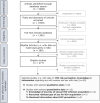Men who have sex with men perceiving that sex with women carries the greatest risk of HIV acquisition: results from a mixed-methods systematic review in sub-Saharan Africa
- PMID: 39690138
- PMCID: PMC11652112
- DOI: 10.1002/jia2.26402
Men who have sex with men perceiving that sex with women carries the greatest risk of HIV acquisition: results from a mixed-methods systematic review in sub-Saharan Africa
Abstract
Introduction: In sub-Saharan Africa (SSA), men who have sex with men (MSM) often have female sexual partners. Their overall risk of acquiring HIV is higher with male partners. Risk perception is associated with HIV knowledge, sexual risk and preventive behaviours. This synthesis aimed to summarize existing data about HIV knowledge and perceived HIV acquisition risk regarding sex with men and with women in MSM in SSA.
Methods: We conducted a systematic literature review of MSM's relationships with women in SSA (PROSPERO-CRD42021237836). Quantitative and qualitative data related to MSM's perceived risk from sex with men and with women and HIV knowledge (published up to 2021) were selected and synthesized.
Results: Twenty studies were selected. More MSM perceived that the greatest risk of HIV acquisition came from heterosexual/vaginal sex than from homosexual/anal sex (53% vs. 15%; 51% vs. 39%; 42% vs. 8%; 27% vs. 25%; 43% vs. 11%; 23% vs. 13%; 35% vs. 16%, cumulative sample n = 4396, six countries). A higher proportion of MSM received preventive information on heterosexual HIV transmission than on homosexual transmission (79% vs. 22%; 94% vs. 67%; 54% vs. 19%; cumulative sample n = 1199, four countries). The qualitative synthesis (eight studies) highlighted biology- and behaviour-based misconceptions leading MSM to perceive lower or negligible HIV risk from sex with men, compared to sex with women. These misconceptions were partly fuelled by the predominant focus on heterosexual and vaginal HIV transmission in HIV prevention information.
Discussion: Common misconceptions regarding sexual risk between men remain unaddressed by the heteronormative messaging of HIV prevention. Underestimation by MSM of their HIV acquisition risk with male partners can pose significant barriers to effective HIV preventive behaviours and strengthen the transmission risk from MSM to their female partners.
Conclusions: Improving access of MSM to tailored HIV prevention information and tools that address their practices with male and female partners is crucial. Integrating messages about anal sex into broader public health initiatives, including sexual health programmes targeting the general population, is essential. Further research in diverse settings in SSA is necessary to gain a greater understanding of the drivers and implications of HIV risk perception in MSM.
Keywords: Africa; HIV prevention; key and vulnerable populations; men who have sex with men; risk perception; women.
© 2024 The Author(s). Journal of the International AIDS Society published by John Wiley & Sons Ltd on behalf of the International AIDS Society.
Conflict of interest statement
The authors have no competing interests to declare.
Figures


References
-
- Fiorentino M, Gravier‐Dumonceau Mazelier R, Yanwou N, Eubanks A, Roux P, Laurent C, et al. Marriage and steady relationships with women in men who have sex with men in sub‐Saharan Africa: a mixed‐method systematic review and meta‐analyses. AIDS Behav. In press.
-
- AIDSinfo | UNAIDS [Internet]. [cited 2023 Apr 19]. Available from: https://aidsinfo.unaids.org/
Publication types
MeSH terms
LinkOut - more resources
Full Text Sources
Medical
Research Materials

